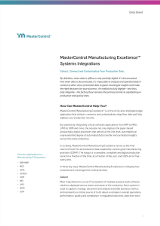Material Requirements Planning (MRP) Integration Solution
Material requirements planning (MRP) software helps companies maintain the minimal amount of inventory to satisfy current and future demand. Yet when an MRP system is disconnected from production records and other shop floor data, a critical gap hinders the ability to collect, connect and analyze the data. MasterControl Manufacturing Excellence™ fills this gap, extending MRP systems to the shop floor for a holistic view of production and quality data.




